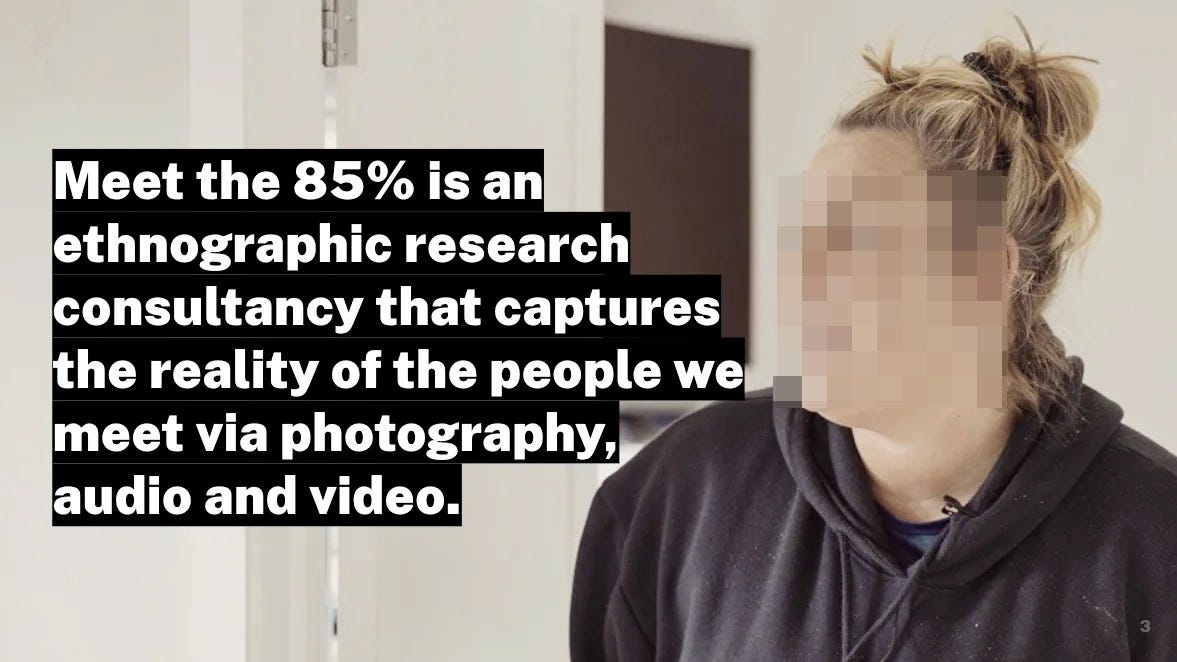Reality first, brand second.
What the smart marketers are asking...
"… that’s it. That’s all we do… it’s not rocket science…”
That may not be the best way to sell your company services, but that’s what we say when we’re sharing our offering with potential new clients.
“We capture the reality of the people we meet.”
And of course, our assertion is that reality is extremely powerful.
So powerful, in fact, that lots of brands don’t really want it unearthed.
So powerful, that businesses get scared of seeing it.
So powerful, insight teams worry about it contradicting existing research.
So powerful, some brands think it too general for them to buy.
Some would rather be insulated from the reality of the lives people are living in the hope that aspirational marketing, or big data, or trend forecasts bring them something more akin to how they want people to perceive their brands.
While the economies of the countries we’re living in are in a ‘doom loop’, and the mass mainstream have less and less money, brands persist in cracking on as normal and tell us everything’s OK. The curse of Aspirational Marketing.
Yet the unfortunate reality is that burying your head in the sand is not an option any more. As our good friend Richard Huntington says: “Hope is not a strategy.”
Reality is here to stay. And for the foreseeable future - whether you like it or not, regardless if it doesn’t align with your brand onion - the reality people are living now and for a while is pretty grim.
When we launched the business, we created some principles of how we would operate. Nothing as lofty (or meaningless, if your bread is buttered that side…) as a ‘purpose’ and a few things that we told ourselves we’d adapt and amend if we needed to.
One of the principles that we’re doubling-down on is:
BE CLEAR WHO WE ARE FOR, AND WHO WE ARE NOT FOR
In short, the products and services we sell aren’t for everyone. Our kind of deep, rich, ethnography isn’t for everyone. Or every business. Or every brand. Or every brief.
It’s a product that is naturally selective. If they see more potential negatives than positives from our approach and potential outputs, it’s probably not for them.
But, for the people who lean in, it can be a game changer. A real opportunity for their careers. A real moment in the life of a brand. A real opportunity to actually make a difference in the lives of people.
Because they can see the power of reality.
They can see the power of looking at reality first, brand second.
Reality first, brand second.
And that again is a simple statement, but profoundly powerful.
These people are prepared to state the obvious: they realise people’s lives do not operate around their brands.
There’s a lot of narcissism in marketing. A lot of ‘brand out’ thinking.
Reality tends to blow that away.
When you see the brand you obsess over, 10 hours a day, 5 days a week, have spent millions building… sat on a shelf at the back of a cupboard, well past its ‘Use-By’ date, and the person who owns it doesn’t even know it’s there…
… that’s reality.
It’s probably like that because your brand, your category, your communications means nothing to them in their lives. Because they woke up thinking about how they’re going to afford the kids school uniform, or make that final payment for their All-Inclusive.
(The reality people are living now was captured in our “What the fuck is going on?” work with Saatchi & Saatchi - there’s an overview here, and Richard and I are presenting a version of it on Monday - details here.)
Like we said, we’re finding the best marketers we’re engaging with - client-side and agency-side - are the ones who are asking powerful questions based on the reality of now. Reality first, brand second.
Some (anonymised) examples of areas we’re looking into for very smart marketers:
“The stock imagery that appears when you search for [our region] isn’t the reality people are living at all. Can you provide us with the reality we can use in our presentations?”
“The brand I work for is omnipresent in people’s daily lives, and I’m in meetings every day where we talk about the brand’s role in people’s lives. Can you show us the reality of whether people even notice us, let alone care about us?”
“We’ve spent 18 months building data-led audience segments, and they’re robust and ‘correct’ but unusable by the business. Can you tell us how you can make them reflect the reality people are living instead of the aspiration?”
“Our product is low-interest and intangible… can you show us the reality of what people think about our category, and if they even know our brand, even though we spend millions on branding?”
These are big, bold, brave questions.
Reality first, brand second.
This post was sparked by two LinkedIn posts I’ve read recently - both incredibly powerful. One from Steve Walls, and one from Edward Cotton.
Kindly, some people tagged us in the ensuing comment conversations. Thank you.





